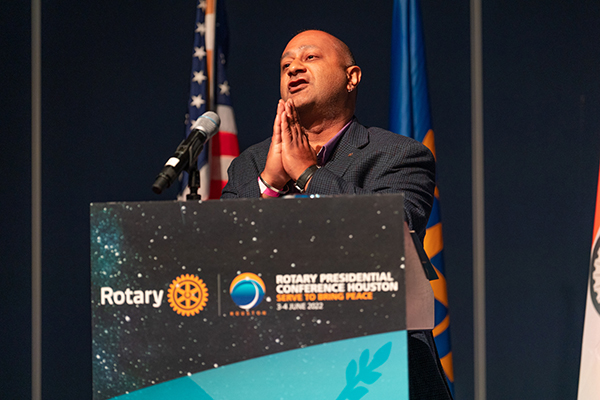
by Kiran Singh Sirah, president of the International Storytelling Center and a Rotary Peace Fellow alum
In early June, I was a keynote speaker at the Rotary Presidential Conference Houston: Serve to Bring Peace. We were a group of about 1,500 people, many who are leaders in their communities, and all interested in peacebuilding. They were from all over the world. And every day, I was asked the question: what led me to become a peacebuilder?
There are so many ways I could answer that question because I’ve been doing this work in one way or another my whole adult life. And even before that, I can trace the answer back to the values that were instilled in me by my parents, who were both refugees driven from their home by a genocidal dictator. I can and do share my “origin story” as a peacebuilder in terms of my family, or explain the trajectory of my career as I’ve been doing this work—but I don’t think that’s what people are really asking when they say: “Why do you do this?”
I think what they want to know is why I believe that peacebuilding is possible. Almost everyone believes in peace, at least in theory. But I think a lot of folks have lost hope in it as a real, attainable goal, and as something we can strive for together. Too many people see peacebuilding as a huge, daunting, totally unrealistic goal. And so an important part of my message everywhere I go is that peacebuilding isn’t just demonstrations and organized actions; it can also be comprised of unexpected connections, small acts of kindness, and quiet conversations in our day-to-day lives. This is work that all of us can do every day, and I think that the stories we share with one another are the structure on which we can build a better future.
To that end, I wanted to share a few ideas based on stories from my own life about how I think we can go about this work.
- Cultivate a can-do attitude.
When I was a little kid on the south coast of England, I’d look out across the sea and imagine the world. I was curious and I wanted to travel, and I loved hearing the stories about the places where my parents had been. When I told my mom I wanted to see the world, she said, “Go on, then.” I packed up a small bag and set out that evening. Of course it started getting dark, and then my socks got wet in a creek a few blocks away from my house. I headed back home, determined to try again a different day.
When we were kids, we had an outsized sense of our ability to do things and our personal impact on the world. We were also less afraid of looking foolish. I remember organizing political protests at my elementary school and writing letters to Ronald Reagan. I think as we get older, the world drums out some of that enthusiasm and earnestness and belief that we can do big things. Part of the work of any type of activism is simply recapturing and nurturing that sense of belief that came so naturally to you as a child.
- Seek perspective.
In high school, one of my teachers, Mr. Ellis, had an interesting and unusual approach to teaching history. Instead of reading about the past, our homework was to watch the evening news. We’d learn about then-current events like the conflict in Northern Ireland and the Arab-Israeli conflicts, and then the next day in school, we’d discuss them. We’d work backwards to learn about what had led to those conflicts, building a deeper, broader sense of understanding. Mr. Ellis encouraged us to explore the different events that started wars, and to research different sides of the story. Essentially, he asked us to work like detectives, to probe and ask questions and to seek the stories behind what we saw, so we could form our own opinions.
- Remember that entrenched problems aren’t permanent.
Sometimes it’s helpful to see an old problem with fresh eyes. In Glasgow, Scotland, there’s an old and horribly violent rivalry between two of the country’s soccer teams, Celtic and Rangers. When I first moved there, I was shocked by how sports and religion and politics all intertwined in this rivalry. Watching a game, you could see hundreds of years of religious turmoil between Catholics and Protestants unfold as fans threw potatoes on the field to mock the descendants of Irish immigrants. And across the city, after games, violence would spill out of the pubs and onto the streets, or even start conflicts between neighbors and families.
As a newcomer, this conflict was shocking to me. But in my conversations, people explained that it was just part of the culture that would never go away. There was a feeling of complacency or even acceptance. I started a program to address it, and I think part of the reason I was able to act was simply because I hadn’t grown accustomed to the problem.
- Don’t reinvent the wheel.
When I was a young education curator, a very talented photographer called Jenny Matthews came for an exhibit and a series of talks. Over coffee in the museum café, I asked her if she’d be willing to offer me a bit of advice. I told her I had this desire to go and do human rights work in the world, perhaps to start a nonprofit. She said, “Why do you want to start a nonprofit when there’s already so many great ones out there?” She really encouraged me to go find an existing project to support that aligned with my vision.
When we’re getting started in our careers, I think there’s a certain amount of ego we bring to the table. But often we can get so much farther if we build on something that already exists.
- Positive outcomes compound over time.
In today’s world, I think we get a little too caught up in the hard facts of metrics. Statistics and measurable outcomes are great, but these tools can’t capture the cumulative and long-term impacts that peacebuilding and storytelling can have. At ISC, we often measure the impact of a particular program on the participants. There are questionnaires and other tools we can use to do this. But that information can’t reflect the big picture of what those participants then go on to contribute in families, schools, workplaces, and wider communities. These are returns on investment that unfold over lifetimes.
I’m still learning from the stories that my parents, teachers, and other mentors shared with me when I was very young. I think about them all the time! I think when we share a story, we don’t necessarily know the impact it will have on someone else. There’s a lot about this work that’s unknowable, but that doesn’t mean the work isn’t taking place.
Stories are living things that shape our understanding and drive us to act. I think of storytelling and peacebuilding as wide and nebulous movements that we can all be part of and contribute to and benefit from. You don’t have to work to end all wars, everywhere. You can just do a little bit every day to make your community a better place to live, and go from there.
Learn more about Rotary Peace Fellowships
This post originally appeared on the International Storytelling Center blog
https://blog.rotary.org/2022/07/12/why-i-am-a-peacebuilder-and-how-you-can-be-one-too/

